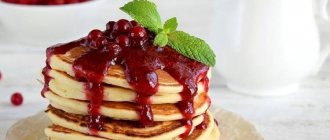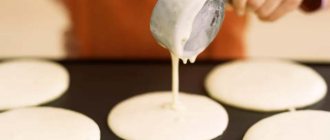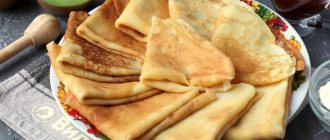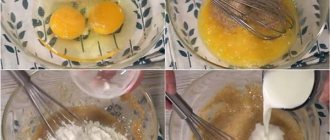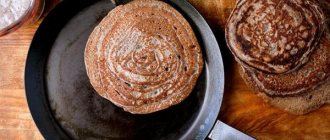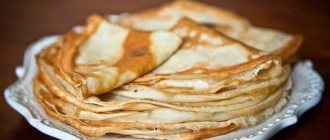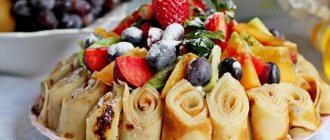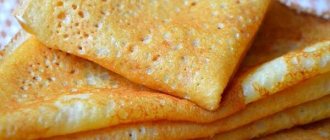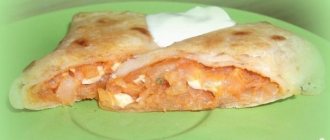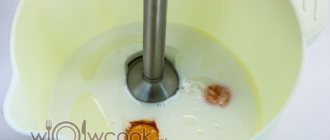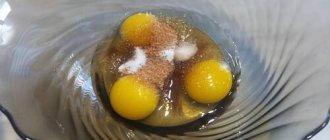It is worth studying the cooking process in more detail in order to understand once and for all what is the secret of whole, crispy, rosy and delicious pancakes and how to fix pancakes sticking to the pan. We also recommend that you look at our website for recipes for pancakes that never tear: made with kefir. as well as lacy pancakes, which always turn out well.
Why pancakes tear when turned over: reasons
Many people wonder how to avoid the product sticking to the bottom of the dish, because this is why pancakes fall apart when the housewife tries to turn them over.
There are many reasons that precede this problem, and it’s worth starting by listing them:
The first thing that comes to mind is the “wrong” frying pan, and in principle, this is a correct guess. The quality of the baked food also depends on the quality of the dishes. To make the dish successful, you will need cast iron utensils with a thick bottom and low sides. However, any damage and scratches can mar the baking and ruin the pancakes, and this fact should be taken into account.
The second common reason for unsuccessful baking is low-quality food products. This can ruin the whole thing:
- tap water instead of filtered;
- rancid, old oil;
- stale eggs that have had time to sit in the store or at home;
- if fermented milk products are used, they must also be fresh, especially kefir, which retains this property only for 3-4 days;
- Well, about the quality of flour - first of all, the taste and specific structure of the dough depend on it, so you need to choose a product of only extra or higher grade.
And finally, the proportionality of the components, the correctness of which affects the thickness of the dough, is also of great importance.
Even the smallest nuances are important:
- The dough for the dish should be moderately viscous and viscous; it is bad when it is too liquid or thick. In order for it to flow as it should, you need to leave it for at least forty minutes.
- Some inexperienced housewives seriously think that if they add enough sugar, they will get fluffier, more rosy pancakes. However, the result of such experiments is quite sad - due to an excess of granulated sugar, the product is fried only on one side, while the other remains raw. And the pancakes tear if there are not enough eggs in them - if you put more, they will be similar in quality to rubber.
- Another important point is that the composition is excessively loose, and this happens due to excess added soda.
It’s easy to ruin a dish by forgetting to add a little oil to the dough, and, of course, you shouldn’t forget to constantly grease the pancake pan with oil.
What to do to prevent pancakes from tearing when flipping
Perhaps, skill comes with experience, but in such a situation there is no point in going your own way of trial and error, when there are certain rules to avoid common troubles and understand what to do so that the pancakes do not tear when turning over:
- You should have a special frying pan in your house, or better yet, a pancake maker, and use it only for this dish. But you need to take proper care of these dishes; do not use a metal sponge, which can erase the fat layer. It is advisable to clean the dishes with a soft brush.
- When preparing the dough, it is important that there are no lumps left in it - it is the homogeneity that prevents the product from breaking.
- Before pouring the dough into the bottom of the pancake pan, you need to keep it on the fire and heat it thoroughly, greasing it with oil using a wooden stick or fork wrapped in gauze. You can also prevent burning and sticking by using lard rather than oil for lubrication.
- The thing to remember is that yeast pancakes and pancakes require low heat, while thin pancakes require medium heat. At excessively high temperatures, the product sticks, may tear and, in addition, burn.
- In addition, you need to “technically” adapt to baking and learn how to turn the products over correctly. Using a wooden spatula, carefully lift the pancake from all sides, and transfer it to the other side only when it is completely separated from the bottom.
- Often the dough is not allowed to rise, and it ends with the dough not being elastic and pliable enough, which is why the pancakes stick to the pan.
- If it happens that the pancake becomes lumpy, then it is better to remove it and rinse the pan thoroughly. In this situation, most likely, the cookware was not hot enough, or some ingredients were missing.
By the way, many very successfully cook pancakes on Teflon dishes, avoiding tears and sticking, adding a little boiling water to the dough before baking.
Tip 2: Heat the pan properly
You started frying pancakes in an insufficiently hot frying pan. This advice is completely true. The frying pan must be heated with oil until the first “smoke” appears - this is an indispensable condition for cooking.
It's all about the same protective film. And during frying, the pan should be well heated. Otherwise, not the first pancake will start to stick, but all the ones following it. Of course, only a more or less experienced housewife can immediately determine the degree of heating of the frying pan. The rest have to check the temperature with the first pancake.
Why do pancakes stick to the pan (what is missing from them)
When setting the goal of baking delicate, rosy pancakes and delighting your loved ones and guests with them, it is important not to skip the most important stage - preparing the pancake batter, which must contain all the necessary components. Sticking that occurs when baking most often means that an ingredient is missing. What is missing is a completely appropriate question that arises.
The main mistakes made by young housewives:
- insufficient number of eggs;
- absence of oil in the dough (just a couple of spoons), and it must be added to the already risen dough.
But there are other omissions:
- perhaps the housewife forgot to sift the flour, and because of this the dough is not too fluffy and there are lumps in it;
- sour milk was used;
- there is too much soda in the composition, which is why it has lost its stickiness (excess can negatively affect the taste of the dish);
- pancakes fall apart from excess sugar, and it also causes pancakes to burn;
- any spices, be it vanilla or cinnamon, are added only in the recommended proportion; excess seasonings disrupt the consistency of the dough, which is why the finished products, a priori, cannot maintain their integrity;
Along with this, experienced housewives do not recommend baking pancakes with margarine or cooking fats containing water.
Let's see how to fix pancakes sticking to the pan when this has already happened:
- put a little oil into the dough;
- if the dough is too thick, it can be diluted with warm milk or water, depending on what the product is prepared with;
- If the composition is too thick, dilute it with an appropriate liquid;
- when acidifying milk, you can add a little soda, flour and boiling water to the dough;
- When the dough literally spreads across the pan, there are not enough eggs in it and you just need to add them, after thoroughly beating and stirring.
In some cases, diluting the dough with carbonated drinks - kumys, beer, or mineral water - helps to save the situation - it all depends on the main idea.
But sometimes the reason for sticking is trivial - there is not enough oil in the pan itself, or the dishes did not have time to heat up. Of course, after all the corrections, before subsequent baking, it is necessary to remove all traces of the unsuccessful first pancake.
When all else fails, it is most likely the frying pan that is at fault and should be replaced.
Compliance with the rules
There are several rules regarding each stage of baking pancakes, if followed, they are guaranteed to turn out golden brown and tasty.
Selection and preparation of dishes
A good pan for cooking pancakes should have a flat and thick bottom. Only under these conditions will its integrity not deform over time under the influence of high temperatures, and the products will not burn and stick to the surface.
Some manufacturers produce special frying pans with heat-resistant handles and low sides, which not only makes the cooking process easier, but also minimizes the risk of burns.
Non-stick pancake pans come in cast iron and aluminum. The former are often additionally equipped with a heating indicator, so they are suitable for novice housewives. Such dishes do not require special care or preliminary preparation. Another option is to buy a pancake maker.
A cast iron frying pan is durable and has high heat capacity. Pancakes do not burn on it and do not curl when removed. Before first use, a clean frying pan must be heated with table salt for 30-40 minutes until it becomes creamy.
After cooling, the dishes need to be washed and dried again, and then greased with fat (vegetable or animal origin) over its entire internal surface and heated for 25-30 minutes over medium heat. This will create an additional protective layer with a non-stick effect.
To ensure that the pancakes turn out perfect and do not stick, you need to allocate a separate medium-sized frying pan in which nothing else should be cooked.
Ingredients
The taste of pancakes and their beautiful appearance depend on the composition of the dough and its consistency. For this, a prerequisite is strict adherence to the recipe.
Interesting! If the pancakes fall apart or tear when turned over, you need to add 1-2 eggs to the dough. They will hold the ingredients together and give the dough elasticity.
Too thin pancakes are obtained due to lack of flour. They tear when turned over, bubble and burn quickly. You can save the dough by adding a little flour to it while stirring constantly. This will avoid excessive thickness and the formation of lumps.
Pancakes mixed with milk often burn and stick to the pan. To prevent this, it is recommended to dilute it by half with boiled water. If the milk in the dough begins to sour, you need to add a pinch of soda or a little boiling water to it, which will neutralize the excess acid.
Pancakes made with kefir turn out to be very tender and delicate, but they often tear. To avoid this, you need to let the product sit for 10-15 minutes before frying. During this time, the percentage of gluten in it will increase, which is responsible for the strength and elasticity of the dough.
Pancakes burn due to excess sugar (more than 1-2 tablespoons). If they are difficult to remove from the pan, there is not enough oil in the dough.
Temperature
Before baking pancakes, the pan must be greased with oil and heated well so that they do not stick or tear. This rule especially applies to aluminum and cast iron cookware that has been previously washed with a brush or cleaning agent. Because of this, it loses the protective layer that prevents the dough from burning.
It’s easy to check if it’s ready – there should be smoke coming from a well-heated frying pan. You need to bake pancakes over medium heat, because on low heat they will not set and will form a lump, but on high heat they will burn.
How to bake pancakes correctly without tearing: tips for beginners
Young housewives who still have little experience in baking pancakes can be given the following useful recommendations:
- You should not rely on your own instincts in preparing the dough - you must strictly adhere to all recipe instructions, especially the ratio of components;
- You cannot put all the flour into the prepared milk (water) at once, or vice versa, pour them into the flour - according to the rules, kneading occurs with the gradual introduction of the component - thus achieving uniformity of the dough;
- when using dry baking powder, you can use more of it than is written in the instructions, at least twice as much as if you were cooking using soda;
- It is advisable not to forget that you need to add a little oil to the dough - this way the product will come off the surface of the pan well;
- the process of slaking soda should not be separated from the dough; experienced chefs advise mixing all the ingredients, including soda, and only then adding diluted vinegar, citric acid, lemon juice;
- in order not to tear the pancake, you need to wait until its edges are fried and then turn it over;
- if you do not allow the dough to rise, then the gluten contained in the flour will not have time to activate, and the dough will not be elastic, as it should be so that there are no tears;
- You need to coat the already heated frying pan with oil, while not forgetting about the sides, to which the edges of the pancakes can stick.
There is no need to remind you that it is permissible to use only fresh products, on which, moreover, the benefits and taste characteristics of the dish depend.
